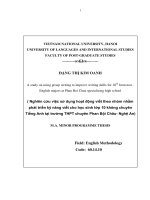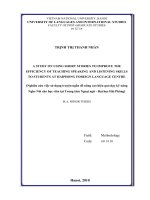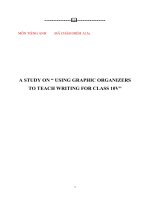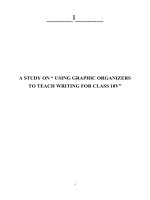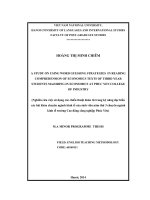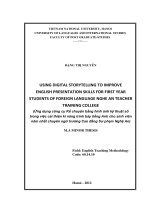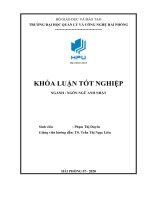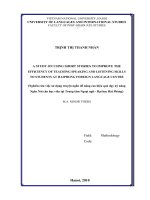A STUDY ON USING GRAPHIC ORGANIZERS TO IMPROVE READING COMPREHENSION SKILLS FOR SECONDARY SCHOOL STUDENTS
Bạn đang xem bản rút gọn của tài liệu. Xem và tải ngay bản đầy đủ của tài liệu tại đây (1.28 MB, 76 trang )
1
MINISTRY OF EDUCATION AND TRAINING
VINH UNIVERSITY
ĐẶNG THỊ THANH THÙY
A STUDY ON USING GRAPHIC ORGANIZERS
TO IMPROVE READING COMPREHENSION SKILLS
FOR SECONDARY SCHOOL STUDENTS
Major: Teaching English to Speakers of Other Languages (TESOL)
Code: 60.14.01.11
MASTER’S THESIS IN EDUCATION
SUPERVISOR: Dr. Nguyen Thi Kim Anh
Nghệ An
i
ACKNOWLEDGEMENTS
This thesis could not have been completed without the help,
encouragement and support of a number of people who all deserve my sincere
gratitude and appreciation.
First and foremost, I would like to express my deepest gratitude to my
supervisor Dr. Nguyen Thi Kim Anh for her invaluable guidance, helpful
suggestions, encouragement in writing this paper.
I would like to thank all the teachers in the English group of Ben Thuy
secondary School, for their help in answering surveys, direct interviews, their
suggestions to this research, and their willingness to share their relevant
problems with me.
I also wish to give my thanks to students at Ben Thuy secondary school
who have actively participated in doing the surveys and responding to my
interviews.
I would like to send my thanks to my lecturers, my friends and my
classmates for their sincere comments and criticism
In the end, I would like to show my big gratitude to my beloved people,
my parents, who have constantly inspired and encouraged me to overcome
difficulties to complete this study.
Finally, a special word of thanks goes to my readers for their interest and
comments on this study.
i
ii
ABSTRACT
The aim of carrying out this study were twofold: (1) using graphic
organizers helps to increase students’ reading comprehension (2) the graphic
organizers help to improve students’ motivation to learn reading skills.
This research was conducted at the seventh grade of Ben Thuy secondary
school in Vinh city. The study involved 60 students in two classes of seventh
grade. The instrument used were tests (pretest and posttest) and questionnaires.
Based on the findings, it is recommended that the teachers need to use
graphic organizers to teach reading skills. This study believes that using graphic
organizers can help students to concentrate on specific information and answer
the questions more detailed. In addition, the teachers should use various graphic
organizers to motivate students and encourage students to read. More
importantly, these strategies were extremely beneficial to classroom instruction.
The thesis also provides implications for English language teaching.
iii
Contents
ACKNOWLEDGEMENTS....................................................................................i
ABSTRACT............................................................................................................i
ABSTRACT..........................................................................................................ii
CHAPTER 1: INTRODUCTION..........................................................................1
1.1. Rationale.........................................................................................................1
1.2. Aims of the Study...........................................................................................4
1.3. Research questions.........................................................................................4
1.4. Scope of the study..........................................................................................4
1.5. Methods of the study......................................................................................5
1.6. Organization of the study...............................................................................5
CHAPTER 2: LITERATURE REVIEW..............................................................6
2.1. Reading and reading comprehension.............................................................6
2.1.1. Reading........................................................................................................6
2.1.2. Definition of reading comprehension........................................................11
2.1.2.5. Techniques to teach reading....................................................................26
2.2. Graphic organizers.......................................................................................29
2.2.1. Definitions of graphic organizers...............................................................29
2.2.2. Roles of graphic organizers.......................................................................29
2.2.3. Types of graphic organizers employed in the research..............................30
CHAPTER 3: METHODOLOGY.......................................................................34
3.1. An overview of Ben Thuy secondary school................................................34
3.2. Learners and learning requirements.............................................................34
3.3. Teachers and teaching methods....................................................................34
3.4. Materials.......................................................................................................35
3.5. Procedures....................................................................................................36
3.6. Tools for Data collection..............................................................................36
3.6.1. The questionnaires.....................................................................................36
iv
3.6.2. Tests...........................................................................................................37
3.7. Data analysis................................................................................................40
CHAPTER 4: FINDINGS AND DISCUSSION..................................................42
4.1. Findings........................................................................................................42
4.1.1. Students’ attitude towards the importance of learning reading
comprehension at school.....................................................................................42
4.1.2.Student’s reading habits.............................................................................43
4.1.3.Student’s difficulties when learning reading skill......................................43
4.1.4.Students’ opinions about teaching and learning reading............................44
4.1.5. The frequency of using strategies designed by teachers............................45
4.1.6. General English test results.......................................................................45
4.1.7. Pre-test and post test result........................................................................46
4.2. Summary and discussion of the main findings.............................................49
CHAPTER 5: CONCLUSION AND IMPLICATION........................................53
5.1. Conclusion....................................................................................................53
5. 2. Implications for more effective reading lessons..........................................55
5.3. Limitations...................................................................................................55
5.4. Suggestions for further research...................................................................56
1
CHAPTER 1
INTRODUCTION
1.1.
Rationale
Nowadays, English has become an international communicative language.
It is widely used in many parts of the world. Therefore, learning English has
been considered a very important duty of many students. One of the most
important skills in learning English as well as other language is reading skill.
Reading skill not only helps students get more information and widen their mind
but also enables them develop language skills such as speaking, listening,
writing.
Reading comprehension is one of the most important skills for
understanding the content that is actually being read. Reading is something that
you can do on your own and that greatly broadens your vocabulary, thus helping
you in speaking (and in listening and writing). Reading is therefore a highly
valuable skill and activity, and it is recommended that English learners try to
read as much as possible in English. Having good reading comprehension skill
is also necessary for passing academic achievement tests and for being able to
read effectively for one's career.
On the other hand, having poor reading comprehension skills can make it
difficult for readers to understand the texts they read, identify themes in stories,
associate what they read with prior knowledge and grasp the main idea of a text.
Many teachers find that their teaching style does not match the learning
style of some of their students. The good step is that using graphic organizers to
prepare and present lessons can have a powerful effect on the students. While
the lesson presentation follows the natural teaching style, students can create a
graphic organizers that matches their learning style. Instead of trying to fit a
mould, they can take notes that feel natural, are easily remembered and suited to
2
their individual style. This makes the best teacher in the world.
Many teachers and lecturers are already adapting graphic organizers to
create powerful classroom presentations, innovative handouts, and an
unforgettable experience for their students. Others are using advanced graphic
organizers to tackle larger classroom projects like innovative long range
educational planning or weekly lesson management that really meets the needs
of individual students.
It is undeniable that the English language has gained more and more
significance in every aspect of society in general and in education in particular.
Realizing the importance of English in education, many policies and renovations
have been promulgated in teaching and learning English during the recent years.
In an attempt to innovate Vietnamese education to meet the demand of the
society in the process of integration and development, the Vietnamese Ministry
of Education and Training has reformed English textbooks concentrating on the
four skills: speaking, listening, reading and writing for secondary school
students since the school year 2006-2007, With this reform, both teachers and
students have certain advantages and disadvantages in mastering the four skills
in the process of teaching and learning English.
Of the four skills, reading, in general, is considered the most difficult not
only students but teachers to master. In reading section in the textbook “English
7”, students are asked to perform tasks of various kinds such as make out the
main ideas, understand the main topic, sentence, paragraph, etc. However, it
seems that some of the reading tasks in the new textbooks have not supported
students’ language acquisition appropriately. Besides, teachers also face certain
difficulties in teaching reading skills.
For many years, teaching reading comprehension was based on a concept
of reading as the application of a set of isolated skills such as identifying words,
3
finding main ideas, identifying cause and effect relationships, comparing and
contrasting, and sequencing. Teaching reading comprehension was viewed as a
mastery of these skills. My students think that it is very difficult to learn reading
skill. I think one of the most powerful tools can be used to improve our reading
comprehension is graphic organizers. Using graphic organizers that show the
relationships between concepts visually and using group reading and tutoring
can also help students develop their reading comprehension skills.
When I have graduated university, I applied for a job at Ben Thuy
secondary school. I teach English subject as a second language. There are four
skills each lesson but my favorite skill is teaching reading because from the text,
students can be easy to use words, structures, sentence to communicate with
many people. There is some difficulty in the reading text, They do not
understand how to answer the questions. So this is a problem that I should worry
and find out the way to help them. I think that whenever reading, they also
understand all the information. Some of them may not have had enough time to
read, they read very quickly but little result. I think it depends on the level of
reading. They have not used right skill. It made them get little information.
Being a teacher of English at secondary school for eleven years, there
searcher has understood the reality of teaching reading in English. The
researcher realizes that the secondary school students in general and 7th form
students in particular do not acquire reading skill efficiently. They seem to
follow these requirements of reading tasks in each lesson in order without
achieving the objectives of the lesson through completing the main tasks with
appropriate skills. Because of the practicality in teaching English reading, this
study was carried out, entitling “A study on using graphic organizers to
improve reading comprehension skills for secondary school students”. The
purpose of the study is to find out if graphic organizers can help students read
4
more effectively. The study is intended to investigate types of activities teachers
use in their reading classes and the efficiency of these activities as well. In
addition, it also seeks to find out to what certain extent these activities have
influence on students’ study achievements. Finally, through the study, some
suggestions are offered so that teachers can use graphic organizers for doing
tasks in the textbook appropriately to improve students” reading skill. Hopefully
that the results of this study would be shared with any colleagues who had the
same problem or anyone who is interested in this study.
1.2. Aims of the Study
The study aimed to help students develop reading comprehension. We find
out the value of the students” comprehension reading level in the Text. There
were some benefits of teaching comprehension by using graphic organizers.
Graphic organizers provide an effective study technique when applied to written
materials the value of level reading comprehension of students with the text. (If
there is any). Improving the motivation how the reading sections in the textbook
“English 7” have been taught at secondary schools with particular reference to
use graphic organizers.
1.3. Research questions
The study aimed to seek the answers to the following questions:
- Will the graphic organizers help to increase student’s reading
comprehension?
- Will the graphic organizers help to improve students’ motivation to learn
reading skill?
1.4. Scope of the study
This study was carried out at Ben Thuy secondary school in Vinh City.
The research focuses on how graphic organizers affect these students’ reading
comprehension in reading lessons. From the findings of the research suggested
5
activities will be given to improve teaching English reading to 7th graders
students
1.5. Methods of the study
The main methods are questionnaires, pre and post tests
1.6. Organization of the study
The thesis consists of five chapters:
Chapter 1: Introduction includes rationale of the study, the aims, scope,
methods, and organization of the study.
Chapter 2: Literature Review
In this chapter, all the theoretical issues related to the topic of the study
are presented. It is concerned with the issues relevant to the topic of the
research: reading and reading comprehension, approaches and techniques to
teach reading
Chapter 3: Methodology
This chapter presents the background information of the subjects of the
study, the instrument used to collect the data, the procedure of data collection
and the procedure of data analysis.
Chapter 4: Findings and Discussions
This chapter aimed at describing data analysis in detail and a thorough
discussion of the findings of the study. Some explanations and interpretations of
the findings are also presented in this chapter.
Chapter 5: Conclusion
This part summarizes the main points based on the results of the study.
This part will also introduce some suggested solutions to improve the English
self-study of students. Further research is also recommended in this chapter.
6
CHAPTER 2
LITERATURE REVIEW
2.1. Reading and reading comprehension
2.1.1. Reading
2.1.1.1. Definition of reading
So far, the term reading has been defined quite differently according to its
various aspects such as criteria, features and functions. For many learners,
reading is a very essential skill, particularly in English as a second language.
Concerning the role of reading, Carrell (1988, p.1) states that “Without solid
reading proficiency, second language learners can not perform at levels they
must in order to succeed”. Reading plays such a significant part in the success of
second language learning and it is essential to understand what reading really is.
Reading is the process of looking at a series of written symbols and
getting meaning from them. When we read, we use our eyes to receive written
symbols (letters, punctuation marks and spaces) and we use our brain to convert
them into words, sentences and paragraphs that communicate something to us.
Reading is a means of language acquisition, of communication, and of
sharing information and ideas. Like all language, it is a complex interaction
between the text and the reader which is shaped by the reader’s prior knowledge,
experiences, attitude, and language community which is culturally and socially
situated. The reading process requires continuous practices, development, and
retirement.
Reading is an interactive process that goes on between the reader and the
text, resulting in comprehension. The text presents letters, words, sentences,
paragraphs that encode meaning. The reader uses knowledge, skills, and
strategies to determine what that meaning is.
As a skill, reading is clearly one of the most important instances around
7
the world, we may argue that reading is the most important foreign language
skill, particularly in cases where students have to read English material for their
own specialist subject but may never actually have to speak the language; Such
cases are
often referred to as ‘English as a library language’. Even though we are
looking at each language skill independently in these chapters, there is clearly an
overlap between reading and writing, in that a ‘text’ has to be written down
before we can read it. In many societies, literature is still seen as the prime
example of writing and therefore one of the first things a student is asked to do is
to read. In classroom terms, one of the reasons for this is partly practical: it is
often thought to be easier to
supply a written text to be read than a spoken one to be understood. Much
of the current thinking on reading tends to focus primarily on the purpose of the
activity; even if reading is done for pleasure it is still purposeful.
Goodman
(1988,
p.135)
declared
that
“reading
is
a
psycholinguistics process by which the reader, language user reconstructs, as
best as he can, a message which has been encoded by a writer as a graphic
display”. From his point of view, readers not only get more knowledge or skill
but also understand the content of the text. According to William, (1990, p.2)
“reading is a process whereby one looks at and understands what has been
written”. In his opinion, in the reading process, there are two activities taking
place at the same time: looking and understanding. Therefore, readers have to
“encode” meanings of a word decided by the context in which it is shown.
Also, Harmer (1989, p.153) shares his ideas “reading is an exercise
dominated by the eyes and the brain. The eyes receive messages and the brain
then has to work out the significance of these messages”. Readers encounter a
lot of difficulties in dealing with proverbs and idioms, synonyms metaphor,
8
metonymy and other types of transference of meaning also cause great difficulty
for readers. Reading is an active skill, involving guessing and predicting. It is
common that there are new words, new structures and ideas in a reading text for
every language learner. If he/she does not have a good guessing ability and
cannot make full use of grammatical, logical and cultural clues, he/she will read
the text with less understanding than he/she might expect, and he/she will feel
frustrated at the text, and will not want to keep on reading. However, teaching
reading comprehension is the problem that teachers should interested because
the students at high school learn English as the second language and they are
poor in knowledge, poor environment and they team English sometimes without
materials.
Reading is a receptive skill with many sub skills just as those involved in
listening. Reading is also very important in real life. People always read for
pleasure or for work. Language learners can learn to use different reading styles.
Some read and understand a text very quickly while others read slowly and fail
to understand what they read.
Hence, clearly, ideas of reading have been diverse in exploiting words and
expressions but they all focus on two actions: studying with eyes and
comprehending with brains of which the latter is more significant. The most
obvious thing in the latter is that the readers not only look at and understand the
meaning of what is written but also read authors’ thinking.
2.1.1.2. The role of reading in learning
Reading plays an inevitably important role in comprehending a text and
using the foreign language appropriately and fluently. “A person’s future
opportunities for success and prosperity will be even more entwined with skill
9
reading abilities. It is therefore an important societal responsibility to offer
every person the opportunity to become a skilled reader, and in many cases, this
means becoming a skilled L2 reader” (Grabe, 2009, p. 6).
It is possible for us to claim that reading has a very important role to play
in language learning as it can bring benefits to learners. William (1984, p. 13)
suggests three advantages of reading to learners: First, learners can have further
practice in the language that they have learnt. This means that learners will have
many opportunities to gain further knowledge of the target language. Second,
learners can practice language in order to reuse it in other skills such as speaking
and writing. Learners cannot understand anything if they cannot read. Third,
learners can learn how to get benefit from the texts to extract the information
they need. The more comprehension learners conceive, the more major
intelligence they receive.
Reading has a large number of major benefits that help learners study
language faster and more successfully. Reading is one of the most essential
skills for language learners. When learners’ reading skill improve, their
listening, speaking, and writing also advance. There are some specific reasons
why learners are encouraged to practice reading. In the first place, the constant
repetition of words and patterns in reading helps you learn and remember
vocabulary and grammar structures. Reading plays an important part in
providing vocabulary and structure types. Learners can understand the usage of
structures better when they catch the meaning of sentences. Secondly, reading is
something readers can do their own. Learners can spend as much time as they
wish on reading by themselves. Language learners are able to practice reading
skill whenever they want. The skill does not extremely depend on others.
2.1.1.3. The reading process
Reading is a complex cognitive process of decoding symbols in order to
10
construct or derive meaning (reading comprehension). It is a means of language
acquisition, of communication, and of sharing information and ideas. Like all
language, it is a complex interaction between the text and the reader which is
shaped by the reader’s prior knowledge, experiences, attitude, and language
community which is culturally and socially situated. The reading process
requires continuous practice and development.
Readers use a variety of reading strategies to assist with decoding (to
translate symbols into sounds or visual representations of speech) and
comprehension. Readers may use morpheme, semantics, and syntax context
clues to identify the meaning of unknown words. Readers integrate the words
they have read into their existing framework of knowledge or schema (schemata
theory). Other types of reading are not speech based writing systems, such as
music notation or pictograms. Currently most reading is either of the printed
word from ink or toner on paper, such as in a book, magazine, newspaper,
leaflet, or notebook, or of electronic displays, such as computer displays,
television, mobile phones or e-readers.
The process of recording information to be read later is writing. In the
case of computer and microfiche storage there is the separate step of displaying
the written text. For humans, reading is usually faster and easier than writing.
Reading is typically an individual activity, although on occasion a person will
read out loud for the benefit of other listeners. Reading aloud for one's own use,
for better comprehension, is a form of intrapersonal communication. Other
methods of teaching and learning to read have developed, and become
somewhat controversial. Reading is an intensive process in which the eye
quickly moves to assimilate text. Very little is actually seen accurately. It is
necessary to understand visual perception and eyes movement in order to
understand the reading process. There are several types and methods of reading,
11
with differing rates that can be attained for each, for different kinds of material
and purposes: Rates of reading include reading for memorization (fewer than
100 words per minute [wpm]); reading for learning (100 -200wpm); reading for
comprehension (200 - 400 wpm); and skimming (4007700 wpm). Reading for
comprehension is the essence of the daily reading of most people. Skimming is
for superficially processing large quantities of text at a low level of
comprehension (below 50%). Advice for choosing the appropriate reading-rate
includes reading flexibly, slowing when concepts are closely presented and
when the material is new, and increasing when the material is familiar and of
thin concept. Speed reading courses and books often encourage the reader to
continually accelerate; comprehension tests lead the reader to believe his or her
comprehension is continually improving; yet, competence-in-reading requires
knowing that skimming is dangerous, as a default habit. Reading speed requires
a long time to reach adult levels.
2.1.2. Definition of reading comprehension
Reading comprehension is the act of understanding what you are
reading. Reading comprehension is an intentional, active, interactive process
that occurs before, during and after a person reads a particular piece of writing.
Reading Comprehension is the ability to understand what we read- where
words have contexts have meaning, Reading comprehension skills allow us to
read proficiently, learn effectively, problem, solve, strategize, conceptualize, and
succeed in life. Without reading comprehension skills, many students are left
behind. Reading comprehension is the heart and gold of reading, since the
purpose of all reading is to gather meaning from the printed page. If a student
says words in a passage without gathering their meaning, one would hesitate to
call that reading.
12
In order to comprehend written texts, the reader needs to have some
basic knowledge, strategies and awareness. These include: the ability to decode
print accurately and fluently, knowledge about language, including vocabulary
and syntax, and strategies for applying that knowledge, knowledge and
experiences of the world, including life experiences, content knowledge,
background knowledge and knowledge about texts, an awareness of their own
processes and strategies as they approach reading.
Relevant processes and strategies include motivation and engagement,
comprehension strategies, monitoring strategies and “fix-up” strategies.
In addition, Silberstein (1994, p.10) elaborated that comprehension is an
active process and the reader must interact and be engaged with the text for it to
work well. It is also a strategic process which can be taught. As comprehension
takes place, words are decoded and associated with their meaning in the reader’s
memory and phrases and sentences are processed rapidly or fluently enough so
that the meanings derived from one world, phrase, or sentence are not lost
before the next is processed. Yet, reading comprehension can be described as
understanding a text that is read, or the process of constructing meaning from a
text.
Grellet
(1981,
p.3)
has
considered
reading
comprehension
or
“understanding a written text means extracting the required information from it
as efficiently as possible”. Reading comprehension is explained as the ability to
understand what has been read. Comprehending involves strategies that students
learn to use when reading independently. Teachers focus on several key
comprehension skills. These are inferring, predicting, comparing and
contrasting, sequencing and summarizing. Students usually learn how to use
these strategies in a small group guided by the teacher who demonstrates their
use. Students then practice comprehension techniques with a partner by discussing
13
what they read, making connections with prior knowledge and identifying the
main ideas in the story.
Reading comprehension is very important because it may be tested by a
passage which is to be translated into good English, or by question based on the
content of a passage. In this case, the passage is not translated, the questions
being asked in the foreign language and the student answering in English.
At this level, the reader is able to go beyond the words on the page and
infer other details for example, to realize that the main character is angry from
what he says and what he does. Being able to operate at the inferential level
means that the reader is using information effectively to deduce cause and effect,
and to anticipate what may come next. At a more demanding level (critical
reading), the reader is able to appraise what he or she is reading for example,
detecting good writing style from the author, recognizing when some statements
in the text are biased or incorrect, appreciating the writer’s viewpoint,
comparing and contrasting information with other facts they have read
elsewhere, and reflecting upon the importance or otherwise of the opinions
presented. Weak readers who are still struggling with word recognition have
enormous difficulty progressing beyond a literal level of comprehension because
most of their cognitive effort is taken up in unlocking the print.
In brief, reading becomes meaningless without comprehension since only
reading comprehension can appreciate how much readers get the text.
2.1.2.1. Reading Comprehension Process
The nature of reading comprehension process – how people learn to
process textual information – has been researched by cognitive and behavioral
scientists for many decades. So far reading has sometimes been characterized as
“passive” or “receptive”.
14
2.1.2.1.1. The Schema Theory
An important source of understanding about the nature of the knowledge
that informs comprehension is schema theory. Schema theory is concerned with
how knowledge is represented and organized in long-term memory (as sets of
information, or schemas) and then brought to mind as new information comes
in. The theory suggests that individuals relate all new information to what they
already know or have experienced. In the context of reading, schema theory
emphasizes the critical role of the reader’s prior knowledge in comprehension.
A schema is a cognitive framework or concept that helps organize and
interpret information. Schemas can be useful because they allow us to take
shortcuts in interpreting the vast amount of information that is available in our
environment. However, these mental frameworks also cause us to exclude
pertinent information to focus instead only on things that confirm our preexisting beliefs and ideas. Schemas can contribute to stereotypes and make it
difficult to retain new information that does not conform to our established ideas
about the world.
Researchers have identified different kinds of schema that are particularly
significant for reading. Content schemas concern knowledge about the world,
ranging from the very personal and every day to broad and specialized
knowledge. Textual schemas concern knowledge that readers (and writers) have
about the forms and organization of written texts, from word-level information
to complex information about structure and register.
Schemas are activated when a reader sees and starts to read a text. The
textual schema will enable the reader to recall and interpret the text in the light
of what they already know about texts, for example, about text types or genres,
vocabulary, different kinds of sentences, tone and register. These schemas may
also enable the reader to make predictions about the kind of text will be by
referring to their stored knowledge of text types. Content schemas will be
15
activated as the reader engages with the words and any pictures in the text, from
the title onwards. For example, as a reader starts an article about rugby, they will
bring to mind everything they already know about rugby. If the reader knows
very little about rugby, the article may be difficult to comprehend. The more
relevant prior knowledge the reader has, the more they will comprehend when
they read a text that connects with their existing content schema.
Readers from diverse cultural and language backgrounds will have
diverse schemas, but for all learners, the more knowledge that is stored, the
more that can be interpreted, understood and added to the store. The implication
is that accessing the learner’s textual schema and building new language
knowledge is the key to increasing expertise in English. Likewise, accessing the
learner’s content knowledge and helping them to relate it to new contexts will
help them comprehend texts in English.
2.1.2.1.2. Bottom – up and Top-down processing
There are two approaches to understanding the process of perception.
These are the top-down processing and the bottom up processing. Topdown and bottom-up are
both
strategies
of information
processing and
knowledge ordering, used in a variety of fields including software, humanistic
and scientific theories , and management and organization. In practice, they can
be seen as a style of thinking, teaching, or leadership.
Top-down processing is defined as the development of pattern recognition
through the use of contextual information. For instance, you are presented with a
paragraph written with difficult handwriting. It is easier to understand what the
writer wants to convey if you read the whole paragraph rather than reading the
words in separate terms. The brain may be able to perceive and understand the
gist of the paragraph due to the context supplied by the surrounding words.
In the bottom-up processing approach, perception starts at the sensory
input, the stimulus. Thus, perception can be described as data-driven. For
16
example, there is a flower at the center of a person's field. The sight of the
flower and all the information about the stimulus are carried from the retina to
the visual cortex in the brain. The signal travels in one direction.
In short, there are two ways that readers can use to deal with a text: using
the bottom – up processing to get detailed understanding of the text and using
the top-down to understand main ideas about the text. Readers may use one of
the two ways to comprehend texts, however, readers usually need both of them
to deal with difficult texts. As a result, this leads to interactive processing.
2.1.2.1.3. Interactive processing
A successful reader should combine top – down and bottom – up
processing, which is called interactive reading:
“In practice, a reader continually shifts from one focus to another, now
adopting a top– down approach to predict probable meaning, then moving to the
bottom – up approach to check whether that is really what the writer says”
(Nuttal, 1996, p. 17).
According to Hayes (1996, p.7), “in interactive models, different
processes are thought to be responsible for providing information that is shared
with other processes. The information obtained from each type of processing is
combined to determine the most appropriate interpretation of the printed pages”.
In short, the popularity of interactive processes shows that interactive
processing can maximize the strengths and minimizes the weaknesses of the
bottom – up and top – down processing.
2.1.2.2. Factors affecting the learning of reading comprehension
The comprehension goals of the intermediate grades address these
abilities as well as those required for independent study: skimming, using
reference materials, outlining, summarizing, altering reading rate and focus as
the purpose of reading changes, use of headings, note taking, and so on. For
many spreading comprehension is a major problem. There are mainly three
17
causes for poor reading comprehension.
Firstly, the person has a language problem. Language plays a vital role in
reading. One cannot read a book in a language unless one knows that particular
language. If a child’s knowledge of English is poor, then his reading will also be
poor, and naturally also his reading comprehension.
Secondly, if the foundational skills of reading have not been atomized. If
the skill on the primary task is automatized, it will not be disrupted by
concurrent processing on the secondary task because automatic processing does
not take up antinational resources. If, on the contrary, the skill is not
automatized, it will be disrupted by concurrent processing of a second skill
because two skills are then competing for limited intentional resources. This also
applies to the act of reading. The person, in whom the foundational skills of
reading have not yet become automatic, will read haltingly and with great
difficulty. The poor reader is forced to apply all his concentration to word
recognition, and therefore has no concentration left’ to decode the written word,
and as a result he will not be able to read with comprehension.
Lastly, threaded is unable to decode the written word. The decoding of the
written word is a very important aspect of the reading act. Without being able to
decode the written word, reading comprehension is impossible. This explains
why some children can read without understanding what they are reading. Many
students do not realize how important it is to be able to fully comprehend what
you read. Being able to completely and accurately comprehend what you read is
essential to your ability to learn, perform well on tests and ultimately succeed in
school and in a career. Anyone who desires to acquire effective study techniques
would do well to improve his reading comprehension skills. Developing reading
comprehension techniques is one of the two basic ways of improving reading
skill, the other being developing reading speed. However, rapid reading is
18
valueless unless what is read is understood.
Experiences are another factor that greatly impact reading comprehension.
If
you have many life experiences that you can draw upon from your
memory bank, you may be more apt to follow along with a given reading
selection, A story that does not make sense to you because you have not lived
that sort of experience before will not be able to hold your interest.
Comprehending reading requires that you delve deep into the characters and
plot, and allow your imagination to soar, transcending time and boundaries, the
creative aspect of your brain needs to be engaged in order to fully understand
different concepts and abstract reasoning. A mastery of vocabulary is an
essential factor that affects reading comprehension. If you possess an expansive
vocabulary, you are more likely to understand textual writing, and you will be
less likely to become frustrated. Knowledge of words is imperative to reading
comprehension, and this can make a written piece come alive for some people.
If the writing is too difficult to understand, a person is more likely to put it down
or lose interest. Soon, you have lost all understanding of the piece, and therefore
your reading comprehension has been compromised. Making connections is an
essential factor that affects reading comprehension. While you read, you should
be able to make connections to yourself, your surroundings, or your
environment. The more that you are able to connect a written work to something
personal, the more apt you are to fully understand. Making connections can truly
allow you to establish and grasp a compelling hold on the written work, and the
more you understand, the more insatiable your thirst for reading will become.
2.1.2.3. Reading purposes and motivation
The problem addressed in this study is that many high school teachers are
unaware of, or mistaken about, specific strategies and practices that actually
19
motivate their students to read, and that What motivates one group of students
may not motivate another. Content-area teachers are often unaware that although
they may not have been trained in teaching reading strategy and may feel as
though teaching reading is not their job, it is an expectation that could largely be
met by the implementation of motivational strategies. When teachers do not
employ motivational strategies, they miss an opportunity to engage students in
reading, ultimately contributing to the decreasing rates of literacy in schools .
The outcome, which is student performance or perception in a classroom setting,
can be affected by the valence and consequence, both of which the teacher has
the power to highlight or alter depending on the preferences of his or her group
of students. The study is significant because although research has been
conducted to determine what motivates students to read, the vast majority of the
literature focuses on elementary- and middle- grade students. In addition, a
disparity in teacher and student perceptions demonstrates a real problem that
must be addressed in order to inform instructors in their delivery and practice
regarding motivational strategies to read.
2.1.2.4. Approaches to Teach Reading
2.1.2.4.1. Grammar-Translation Approach
The Grammar Translation Method is a method which was originally used
to teach dead languages, which explains why it focuses mainly on the written
form at the expense of the oral form. It was designed according to the faculty
psychology approach which was very popular during the 18th and 19th century.
It contended that “mental discipline was essential for strengthening the powers
of the mind”. The way to do this was through learning classical literature of the
Greeks and Romans.
The main principles on which the Grammar Translation Approach are
based are the following:
20
Firstly, translation interprets the words and phrases of the foreign
languages in the best possible manner.
Secondly, the phraseology and the idiom of the target language can best
be assimilated in the process of interpretation.
Thirdly, the structures of the foreign languages are best learned when
compared and contrast with those of mother tongue.
Grammar-translation approach has some advantages. Firstly, translation is
the easiest and shortest way of explaining meaning of words and phrases.
Secondly, learners have no difficulties to understand the lesson as it is carried
out in the mother tongue. Thirdly, it is a labor-saving method as the teacher
carries out everything in the mother tongue.
However, there are some drawbacks. Firstly, what the method is good at is
“teaching about the language”, not “teaching the language”. Secondly, speaking
or any kind of spontaneous creative output was missing from the curriculum.
Thirdly, students lacked an active role in the classroom. Fourthly, very little
attention is paid to communication and content. Finally, translation is sometimes
misleading.
2.1.2.4.2. Communicative Language Teaching Approach
Communicative Language Teaching (CLT) which is an approach to the
teaching of second and foreign languages, emphasizes interaction as both the
means and the ultimate goal of learning a language.
Most present-day practitioners would probably like to think that their
classes are "communicative" in the widest sense of the word. Their lessons
probably contain activities where learners communicate and where tasks are
completed by means of interaction with other learners. To this end there will
probably be considerable if not extensive use of pair, group and mingling
activities, with the emphasis on completing the task successfully through
communication with others rather than on the accurate use of form. During these
activities the teacher’s role will be to facilitate and then to monitor, usually
